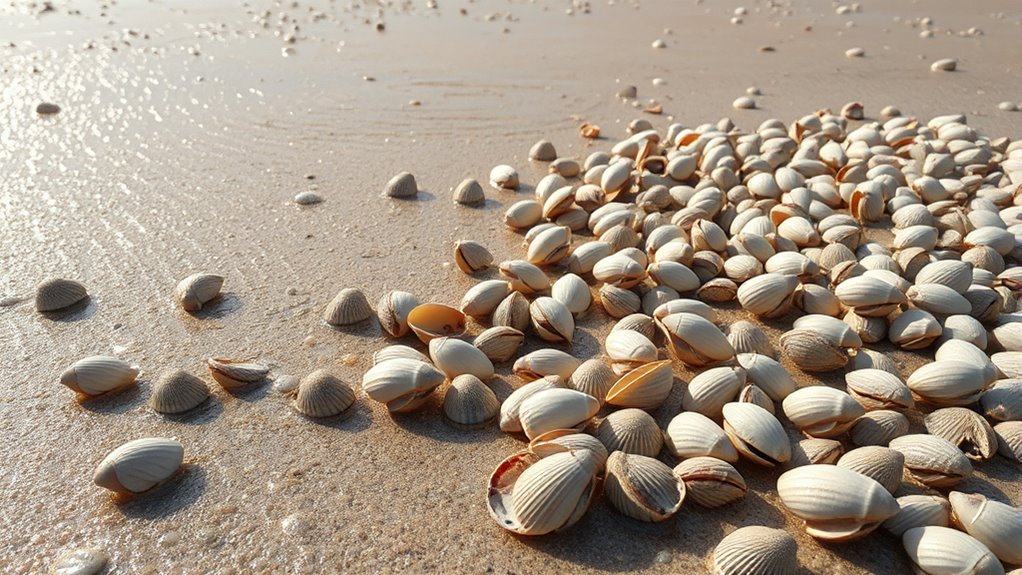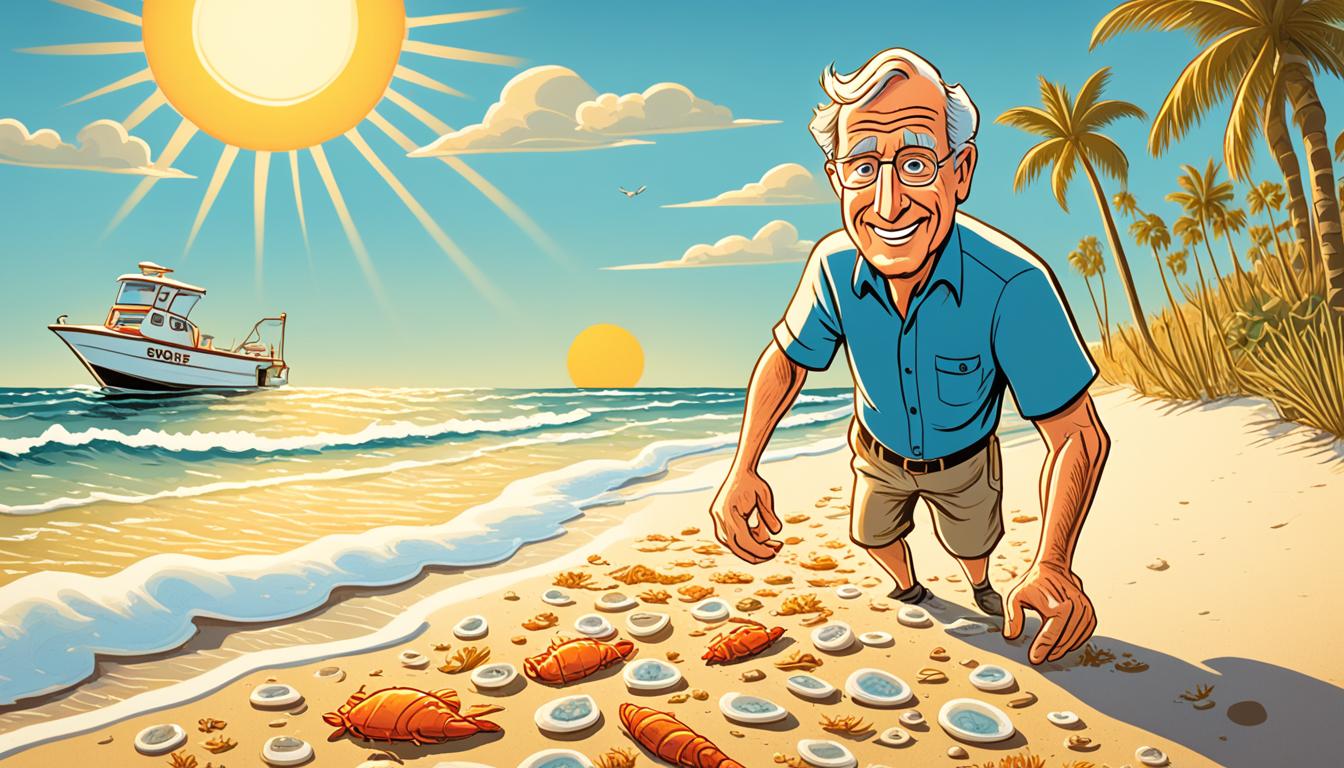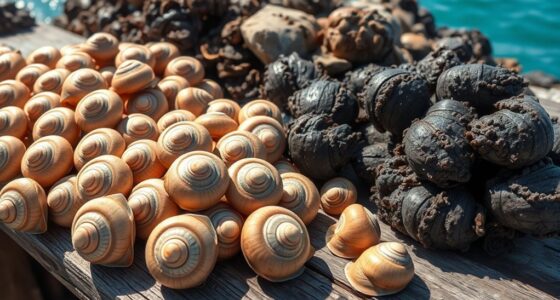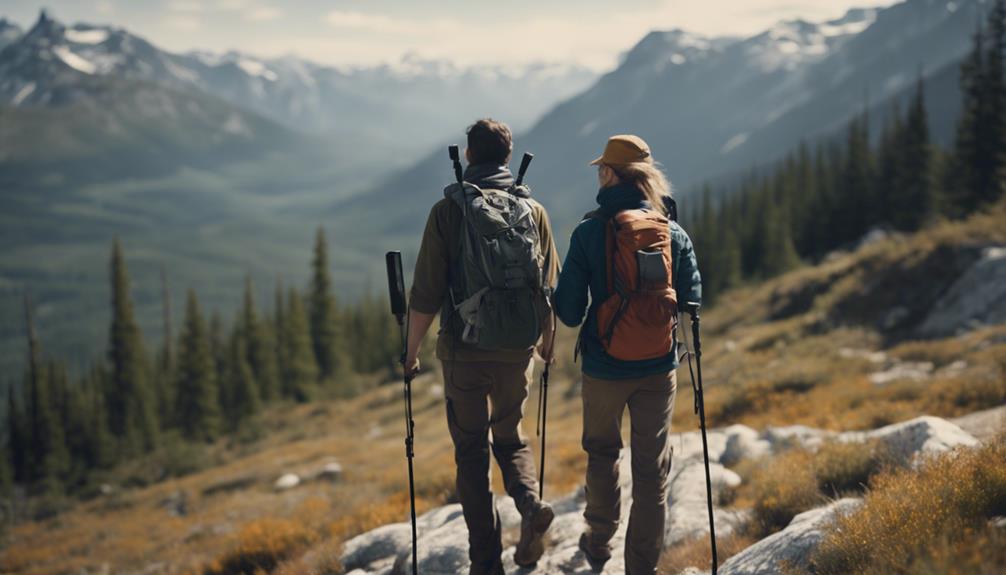Sand flats and mudflats are essential coastal areas where cockles and clams thrive, helping to keep sediments stable and support diverse ecosystems. These bivalves filter water, improve its quality, and prevent erosion, making them critical for ecological health. Their presence indicates a healthy environment, and protecting their habitat is necessary for maintaining biodiversity. If you want to discover more about how these species shape coastal habitats, keep exploring these fascinating ecosystems.
Key Takeaways
- Cockles and clams thrive in stable sand and mudflats, which provide secure burrowing and feeding habitats.
- Their filter-feeding activity improves water quality and supports the ecological health of sedimentary habitats.
- These bivalves are key indicators of healthy, stable ecosystems in coastal sand flats and mudflats.
- Sediment stability prevents erosion, maintaining habitat integrity vital for cockles, clams, and associated species.
- Human activities like dredging threaten sediment stability, risking habitat loss for cockles, clams, and other coastal fauna.

Sand flats and mudflats are dynamic coastal environments that play a pivotal role in supporting diverse ecosystems. These habitats serve as biodiversity hotspots, attracting a wide variety of species that depend on them for food, shelter, and breeding grounds. As you explore these areas, you’ll notice how essential sediment stability is to maintaining the health and resilience of these ecosystems. Sediment stability ensures that the delicate balance of these habitats remains intact, preventing erosion and supporting the growth of benthic organisms like cockles and clams.
In these environments, sediment stability is indispensable because it influences how organisms burrow and filter feed. Cockles and clams, in particular, thrive in stable sediments because they can anchor themselves securely, reducing the risk of being swept away by currents or storms. When sediment is unstable or disturbed—whether through natural processes or human activity—these bivalves struggle to survive, which in turn affects the entire food web. Their presence indicates a healthy, stable ecosystem, making them key species in maintaining biodiversity hotspots along coastlines.
You’ll find that the structure of sand flats and mudflats allows for a rich diversity of life. The fine sediments provide an ideal habitat for burrowing species like cockles and clams, which sift through the substrate for plankton and organic matter. These filter feeders play an important role in water quality, removing excess nutrients and particles from the water column. Their activity enhances sediment stability by preventing excessive erosion, creating a positive feedback loop that supports more organisms and maintains the ecological integrity of these habitats.
Furthermore, these environments are highly productive, supporting not just cockles and clams but also a myriad of other invertebrates, fish, and bird species. Their importance goes beyond biodiversity; they also protect coastlines from erosion and storm surges by absorbing wave energy. As you observe these habitats, keep in mind that maintaining sediment stability is key to preserving their biodiversity hotspots. Human activities like dredging, construction, and pollution threaten this delicate balance, risking the collapse of these rich ecosystems. Protecting sand flats and mudflats means safeguarding the sediment stability that underpins the entire community of life they support, ensuring that cockles, clams, and countless other species continue to thrive in these essential coastal zones. Additionally, the integration of automated technologies such as robotics can assist in monitoring and protecting these sensitive habitats from human-induced disturbances.
Frequently Asked Questions
How Do Cockles and Clams Breathe Underwater?
You might wonder how cockles and clams breathe underwater. They do this through their gill function, where they extract oxygen from water. They use a siphon to draw in water, which passes over their gills, allowing them to absorb oxygen efficiently. When they need to breathe, they extend their siphon to the surface or water flow, ensuring a continuous supply of oxygen while filtering out waste.
What Predators Hunt Cockles and Clams?
You should know that predators like birds, crabs, and fish hunt cockles and clams, creating predator-prey relationships that keep their populations in check. Humans also hunt them for food and bait, which impacts their numbers and the ecosystem. These interactions influence local biodiversity and highlight the importance of sustainable harvesting practices to prevent overexploitation and preserve the balance in their habitats.
Can Cockles and Clams Live Out of Water?
You might think cockles and clams can survive out of water, but they can’t for long. Their burrowing behavior keeps them submerged, where they thrive, and their reproductive strategies depend on moist environments. When exposed to air, they quickly dry out and can’t breathe, making prolonged survival impossible. So, unless they’re back in water soon, they risk drying up and dying, highlighting how essential their aquatic habitat truly is.
How Do Environmental Changes Affect Their Populations?
Environmental changes, like climate change and pollution impact, profoundly affect cockle and clam populations. Rising temperatures can alter their habitats, making it harder for them to survive or reproduce. Pollution, especially in water, contaminates their food sources and can lead to disease or death. You’ll notice population declines or shifts as these factors disrupt their delicate ecosystems, threatening their future and the balance of the coastal environment.
Are Cockles and Clams Safe to Eat?
Yes, cockles and clams are generally safe to eat if you follow proper harvesting methods. Make sure you harvest from clean, uncontaminated waters, and avoid collecting after heavy rains or from polluted areas. Their culinary uses are diverse, from steaming and baking to adding them to soups and pasta. Always cook them thoroughly to eliminate any harmful bacteria or toxins, ensuring a safe and delicious meal.
Conclusion
Think of sand flats and mudflats as the silent guardians of the shoreline’s secret world. Like keepers of ancient stories, cockles and clams hide beneath the surface, patiently balancing the ebb and flow of life. By protecting these vibrant ecosystems, you’re preserving the delicate dance of nature’s hidden treasures. Remember, each tiny shell is a chapter in the ocean’s endless story—guard it well, for it’s a legacy worth defending.










